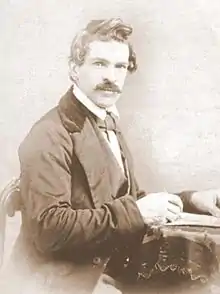Charles Christian Nahl
Carl Christian Heinrich Nahl (October 18, 1818 – March 1, 1878), later known as Charles Nahl (sometimes he is recorded as Karl Nahl, Charles Christian Nahl or Charles C. Nahl), was a German-born painter who lived in the United States for the last half of his life. He lived most of those 30 years in California and is considered among the state's first significant painters.

Leaving political unrest in the Electorate of Hesse and France, Nahl immigrated to New York City in 1848 with family and friends. He moved to California the following year, at first hoping for luck in the gold rush. He and his family settled in what became part of the United States, living in Sacramento until 1852 and then in San Francisco.
Early years
Born in 1818, Carl Christian Nahl was the son of Georg Valentin Friedrich Nahl (1791–1857) and Henriette (Weickh) Nahl (1796–1863). His parents divorced in 1826. He came from a long line of artists and sculptors. His great-grandfather was Johann August Nahl, a German sculptor and Stuckist.
Nahl was trained at the Kassel Academy.
Career

At the time of rising political tensions in Electorate of Hesse in the 1840s, Nahl and his friend Frederick August Wenderoth (1819–1884) moved to Paris in 1846. There he enjoyed some success at the salon and changed his name to the French version, "Charles".[1]
The February Revolution of 1848 prompted another move by Nahl and Wenderoth. They were accompanied this time by Nahl's mother and siblings, including half-brother Hugo Wilhelm Arthur Nahl (1833–1889) and half-sister Laura Nahl (d. 1857). They emigrated to Brooklyn, New York, where they heard of the gold strike.
Nahl reached Nevada City, California the next year, and moved to Rough and Ready, California.[2] Here, he mistakenly purchased a "salted" mine.
Having no luck in mining along the Yuba River, Nahl and his young half-brother Arthur opened a studio with Wenderoth in Sacramento, which was booming with mining-related businesses. They painted images of miners and life on the frontier. After the 1852 Sacramento fire, they moved to San Francisco. (Arthur Nahl made an illustration of the fire).
Wenderoth left for a trip to the South Seas and Australia, through 1853. After his return, in 1856, he married Laura Nahl, his friend's half-sister. They moved to Philadelphia, Pennsylvania, where they intended to settle. Laura died later that year or in 1857, in the birth of their first child, who also died.[3] Wenderoth lived and worked for a time in South Carolina, then returned to Philadelphia.[4]
Olympic Club
The Nahl brothers were also fine athletes. At their home in San Francisco's Bush Street, they created a backyard gymnasium that served as the early version of the Olympic Club. It was the headquarters for the Club from 1855 to 1860. His brother Arthur Nahl suggested naming it the "San Francisco Olympic Club". At the inaugural meeting on May 6, 1860, Arthur Nahl was elected as its Leader.[5]
Selected gallery
 Incident on the Chagres River (Nahl, 1850), Bancroft Library
Incident on the Chagres River (Nahl, 1850), Bancroft Library The lone prospector, 1853, Browere
The lone prospector, 1853, Browere Unidentified Man (Nahl, 1867), de Young Museum, San Francisco.
Unidentified Man (Nahl, 1867), de Young Museum, San Francisco. The Rape Of The Sabines—The Invasion (Nahl, 1871), Crocker Art Museum
The Rape Of The Sabines—The Invasion (Nahl, 1871), Crocker Art Museum Peter Quivey and the Mountain Lion, Nahl
Peter Quivey and the Mountain Lion, Nahl
References
- Palmquist, Peter E.; Thomas R. Kailbourn (2000). Pioneer photographers of the far west: a biographical dictionary, 1840-1865. Stanford University Press. pp. 415–417. ISBN 0-8047-3883-1.
- Comstock, David A. (January 2010). "Gold Rush Art and Wood Engraving". Bulletin. Nevada City, California: Nevada County Historical Society. 29 (1): 4.
- Driesbach, Janice (1998). Art of the Gold Rush. University of California Press. p. 129. ISBN 978-0520214316.
- Teal, Harvey S. Partners with the Sun: South Carolina Photographers, 1840-1940. Univ of South Carolina Press, 2001. ISBN 9781570033841, p. 60
- Janssen, Frederick William (1888). A History of American amateur athletics and aquatics: with the records (Digitized Mar 9, 2010 ed.). Outing Co. p. 131.
External links
- Watercolor gallery of the Los Angeles County Museum of Art
- link collection on Artcyclopedia
- Romans and Sabines Crocker Art Museum online